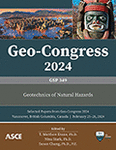Evaluation of Pile Capacities under Local Scoured Conditions
Publication: Geo-Congress 2024
ABSTRACT
Local scour occurs around pile foundations supporting bridges and marine structures due to currents and waves, which can severely undermine the performance of piles in extreme weather events such as floods and hurricanes. A scour hole is often developed around the pile foundation by local scour. In general design practice for pile foundations, scour-hole dimensions are either completely ignored or simply considered but with different methods. This paper reviews the current methods available for the evaluation of the effects of scour-hole dimensions on pile axial and lateral capacities. These methods include the methods outlined in the US Federal Highway Administration Driven Piles and Drilled Shafts as well as the American Petroleum Institute. A case regarding piles in dense sands subjected to different scour-hole conditions was analyzed using these methods. The analyzed results were compared to the results from the three-dimensional continuum finite element analysis and analytical solutions. Based on the comparisons, the pros and cons of each method were discussed. Recommendations on selecting a proper method for the design were also given.
Get full access to this article
View all available purchase options and get full access to this chapter.
REFERENCES
API (American Petroleum Institute). (2011). API Recommended Practice, Geotechnical and Foundation Design Considerations. American Petroleum Institute.
Arneson, L., Zevenbergen, L., Lagasse, P., and Clopper, P. (2012). Evaluating scour at bridges. National Highway Institute (US).
Brown, D. A., and Castelli, R. J. (2010). “Construction Procedures and LRFD Design Methods.” Washington,D.C.
Brown, D. A., Morrison, C., and Reese, L. C. (1988). “Lateral load behavior of pile group in sand.” Journal of Geotechnical Engineering-Asce, 114(11), 1261–1276.
Brown, D. A., Reese, L. C., and O’Neill, M. W. (1987). “Cyclic Lateral Loading of a Large Scale Pile Group.” Journal of Geotechnical Engineering, 113(11), 1326–1343.
Bayram, A., and Larson, M. (2000). “Analysis of scour around a group of vertical piles in the field.” J. Waterw. Port Coast. Ocean Eng. 126, 215–220.
Butch, G. K. (1996). “Scour-hole dimensions at selected bridge piers in New York.” Presented at the North American water and environment congress & destructive water, American Society of Civil Engineers (ASCE), Anaheim, California, USA.
Cox, W. R., Reese, L. C., and Grubbs, B. R. (1974). “Field testing of laterally loaded piles in sand.” Proceedings of the Offshore Technology ConferenceHouston, Texas, 2079.
DNV (Det Norske Veritas). (2014). Design of offshore wind turbine structures. Det Norske Veritas (DNV), Oslo, Norway.
GL (Germanischer Lloyd). (2012). Guideline for the certification of offshore wind turbines. Germanischer Lloyd (GL) Renewables Certification, Hamburg, Germany.
Hannigan, P. J., Rausche, F., Likins, G. E., Robinson, B. R., and Becker, M. L. (2016). Design and Construction of Driven Pile Foundations-Volume II. Federal Highway Administration, U.S. Department of Transportation, Washington,DC.
Jiang, W., and Lin, C. (2021). “Scour effects on vertical effective stresses and lateral responses of pile groups in sands.” Ocean Engineering, 229, 109017.
Lagasse, P., Clopper, P., Pagan-Ortiz, J., Zevenbergen, L., Arneson, L., Schall, J., and Girard, L. (2009). Bridge scour and stream instability countermeasures: experience, selection, and design guidance: Volume 2. National Highway Institute (US).
Lin, C., Han, J., Bennett, C., and Parsons, R. L. (2014). “Analysis of laterally loaded piles in sand considering scour hole dimensions.” Journal of Geotechnical and Geoenvironmental Engineering, 140(6), 04014024.
Lin, C., Han, J., Bennett, C., and Parsons, R. L. (2016). “Analysis of laterally loaded piles in soft clay considering scour-hole dimensions.” Ocean Engineering, 111, 461–470.
Lin, C., and Jiang, W. (2019). “Evaluation of vertical effective stress and pile tension capacity in sands considering scour-hole dimensions.” Computers and Geotechnics, 105, 94–98.
Lin, C., and Wu, R. (2019). “Evaluation of vertical effective stress and pile lateral capacities considering scour-hole dimensions.” Canadian Geotechnical Journal, 56(1), 135–143.
Lin, Y., and Lin, C. (2019). “Effects of scour-hole dimensions on lateral behavior of piles in sands.” Computers and Geotechnics, 111, 30–41.
Lin, Y., and Lin, C. (2020). “Scour effects on lateral behavior of pile groups in sands.” Ocean Engineering, 208, 107420.
Reese, L. C., and Van Impe, W. (2001). Single piles and pile groups under lateral loading, 2nd ed. CRC Press/Balkema, Leiden, The Netherlands.
Sun, Y., Song, Y., and Bian, S. (2007). Scour process around the pile foundation of marine platforms and analysis of scour mechanics. Period. Ocean Univ. China, 636–640.
Sheppard, D. M. (2003). “Scour at complex piers ”. Florida Department of Transportation (FDOT), Tallahassee, FL, USA.
Whitehouse, R. (1998). Scour at marine structures: A manual for practical applications, Thomas Telford.
Information & Authors
Information
Published In
History
Published online: Feb 22, 2024
ASCE Technical Topics:
- Analysis (by type)
- Bridge foundations
- Bridge tests
- Caissons
- Driven piles
- Engineering fundamentals
- Field tests
- Finite element method
- Foundation design
- Foundations
- Geotechnical engineering
- Hydraulic engineering
- Hydraulics
- Methodology (by type)
- Numerical methods
- Pile foundations
- Piles
- Scour
- Tests (by type)
- Three-dimensional analysis
- Water and water resources
Authors
Metrics & Citations
Metrics
Citations
Download citation
If you have the appropriate software installed, you can download article citation data to the citation manager of your choice. Simply select your manager software from the list below and click Download.
